- collaboration
Invite Team Members
Assign Projects
Users & Role Management
Review Management [Test Cases]
Review Management [Elements]
Execution Controls
Manage Test Cases
Test Case List Actions
Import and Export Test Cases
Import Test Project Test Cases
Importing Postman Collections and Environments
Update Test Case result in a Test Plan
Test Cases (Mobile Web App)
- Test Step Types
Type: Natural Language
Type: REST API
Type: Step Group
Type: For Loop
Type: While Loop
Type: Block
Type: If Condition
Nested Step Groups
Image Injection
Cross-application testing
- Test Data Types
Raw
Parameter
Runtime
Random
Data Generator
Phone Number
Mail Box
Environment
Concat Test Data
Create Test Data [Parameter]
Update Test Data Profile
Updating Value in TDP
Import TDP
Bulk Deletion of a Test Data Profile
Create Test Data [Environment]
- Elements (Objects)
- Web Applications
Record Single Element
Record Multiple Elements
Create Elements
Supported Locator Types
Formulating Elements
Shadow DOM Elements
Verifying elements in Chrome DevTools
Handling iframe Elements?
Dynamic Locators using Parameter
Dynamic Locators using Runtime
Using Environment Test Data for Dynamic Locators
Locating Dynamic Elements in Date Widget
Freeze & Inspect Dynamic Elements (WebPage)
Locating Dynamic Elements in Tables
Import/Export Elements
AI Enabled Auto-Healing
Locator Precedence (Web Apps)
Verify Elements from Test Recorder
- test step recorder
Install Chrome Extension
Install Firefox Extension
Install Edge Extension
Exclude Attributes/Classes
- test plans
Add, Edit, Delete Test Machines
Add, Edit, Delete Test Suites
Schedule Test Plans
Run Test Suites In Parallel
Cross Browser Testing
Distributed Testing
Headless Testing
Test Lab Types
Disabling Test Cases in Test Plans
AfterTest Case
Post Plan Hook
AfterTest Suite
Email Configuration in Test Plan
Execute Partial Test Plans via API
Ad-hoc Run
Test Plan Executions
Dry Runs on Local Devices
Run Tests on Private Grid
Run Tests on Vendor Platforms
Run Test Plans on Local Devices
Test Locally Hosted Applications
Debug Test Case Failures
Parallel and Allowed queues
- debugging
Debug results on local devices (Web applications)
Debug Results on Local Devices
Launch Debugger in the Same Window
- Testsigma Agent
Pre-requisites
Setup: Windows, Mac, Linux
Setup: Android Local Devices
Setting up iOS Local Devices
Update Agent Manually
Update Drivers Manually
Delete Corrupted Agent
Delete Agents: Soft & Permanent
Triggering Tests on Local Devices
- troubleshooting
Agent - Startup and Registration Errors
Agent Logs
Upgrade Testsigma Agent Automatically
Specify Max Sessions for Agents
Testsigma Agent - FAQs
- continuous integration
Test Plan Details
REST API (Generic)
Jenkins
Azure DevOps
AWS DevOps
AWS Lambda
Circle CI
Bamboo CI
Travis CI
CodeShip CI
Shell Script(Generic)
Bitrise CI
GitHub CICD
Bitbucket CICD
GitLab CI/CD
- desired capabilities
Most Common Desired Capabilities
Browser Console Debug Logs
Geolocation Emulation
Bypass Unsafe Download Prompt
Geolocation for Chrome & Firefox
Custom User Profile in Chrome
Emulate Mobile Devices (Chrome)
Add Chrome Extension
Network Throttling
Network Logs
Biometric Authentication
Enable App Resigning in iOS
Enable Capturing Screenshots (Android & iOS)
Configure Android WebViews
Incognito/Private mode
Set Google Play Store Credentials
- addons
What is an Addon?
Addons Community Marketplace
Install Community Addon
Prerequisites(Create/Update Addon)
Create an Addon
Update Addon
Addon Types
Create a Post Plan Hook add-on in Testsigma
Create OCR Text Extraction Addon
- configuration
API Keys
- Security(SSO)
Setting Up Google Single Sign-On(SSO) Login in Testsigma
Setting Up Okta Single Sign-On Integration with SAML Login in Testsigma
Setting up SAML-based SSO login for Testsigma in Azure
iOS Settings
Creating WDA File for iOS App Testing
- uploads
Upload Files
Upload Android and iOS Apps
How to generate mobile builds for Android/iOS applications?
- Testsigma REST APIs
Environments
Elements
Test Plans
Upload Files
Get Project Wide Information
Upload & Update Test Data Profile
Fetch Test Results (All Levels)
Trigger Multiple Test Plans
Trigger Test Plans Remotely & Wait Until Completion
Run the Same Test Plan Multiple Times in Parallel
Schedule, Update & Delete a Test Plan Using API
Update Test Case Results Using API
Create and update values of Test Data Profile using REST API
Rerun Test Cases from Run Results using API
- open source dev environment setup
macOS and IntelliJ Community Edition
macOS and IntelliJ Ultimate Edition
Windows and IntelliJ Ultimate Edition
Setup Dev Environment [Addons]
- NLPs
Retrieve Value in Text Element
Capture Dropdown Elements
Unable to Select Radiobutton
Unable to Click Checkbox
Clearing the Session or Cookies
UI Identifier NLP
Drag & Drop NLP
Uploading Files NLP
- setup
Server Docker Deployment Errors
Secured Business Application Support
Troubleshooting Restricted Access to Testsigma
Why mobile device not displayed in Testsigma Mobile Test Recorder?
Unable to Create New Test Session
Agent Startup Failure Due to Used Ports
Tests Permanently Queued in Local Executions
Fix Testsigma Agent Registration Failures
Testsigma Agent Cleanup
Need of Apache Tomcat for Testsigma Agent
- web apps
URL not accessible
Test Queued for a Long Time
Issues with UI Identifiers
Missing Elements in Recorder
Collecting HAR File
Errors with Browser Session
Page Loading Issues
- mobile apps
Failed to Start Mobile Test Recorder
Troubleshooting “Failed to perform action Mobile Test Recorder” error
Test Execution State is Queued for a Long Time
Mobile app keeps stopping after successful launch
More pre-requisite settings
Unable to start WDA Process on iPhone
Most Common causes for Click/Tap NLP failure
Finding App Package & App Activity (Android)
Cross-environment Compatible ID Locators (Android)
Why Accessibility IDs Over other Locators?
Common Android Issues & Proposed Solutions
Finding the App Bundle ID for iOS
- on premise setup
On-Premise Setup Prerequisites
On-Premise Setup with Docker-compose File
Post-Installation Checklist for On-Premise Setup
Install Docker on an Unix OS in Azure Infrastructure
SMTP Configuration in Testsigma
Configure Custom Domains
- salesforce testing
Intro: Testsigma for Salesforce Testing
Creating a Connected App
Creating a Salesforce Project
Creating Metadata Connections
Adding User Connections
Build Test Cases: Manual+Live
Salesforce Element Repositories
Intro: Testsigma Special NLPs
Error Handling On Metadata Refresh
Automating Listview Table NLPs
- windows automation
Intro: Windows Desktop Automation
Windows (Adv) Project & Application
Object Learning (Using UFT One)
Converting TSR Files to TSRx
Importing/Updating TSRx Files
Test Cases for Windows Automation
Error Handling Post TSRx File Update
Run tests in parallel
You can configure your test plans to run in parallel at any time. However, the number of tests you can execute at once in parallel depends on your account plan and the parallel tests you have left.
You can
- Configure tests to run in parallel while creating a new Test Plan.
- Configure tests to run in parallel with editing an existing Test Plan.
You should already know how to List,create,edit or delete test plans.
Configure tests to run in parallel while creating a new test plan
- When you are creating a new test plan, this action can be taken on tab 2 - Test Machines and Suites Selection
-
On the Test Machines and Suites Selection tab, you can either:
- Run Test Suites in Parallel: This option will be available for your test machine, if it has more than one test suite added. As highlighted in the screenshot below, OR
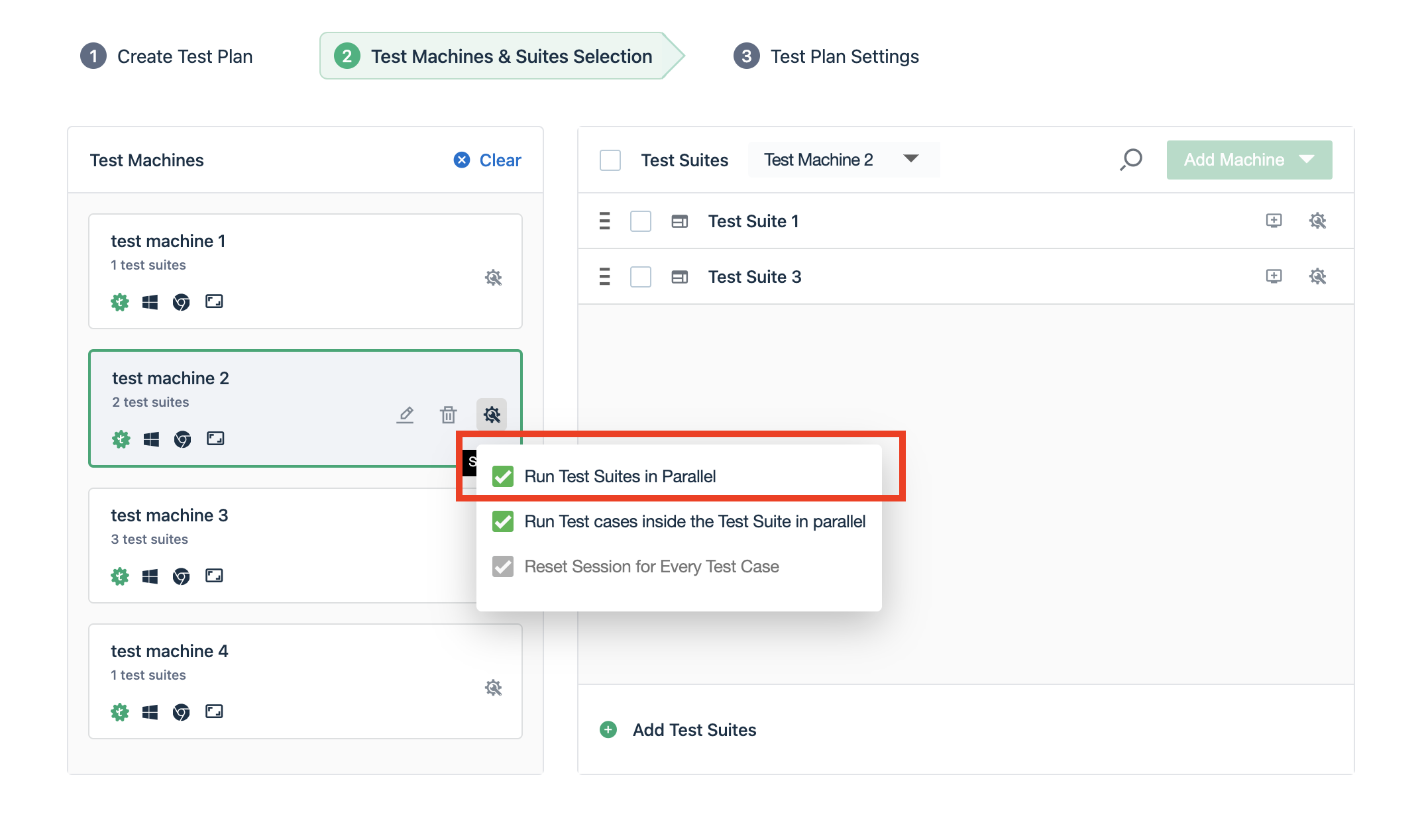
- Run Test Cases inside the Test Suite in Parallel: This option will be available for your test machine as shown in the screenshot below:
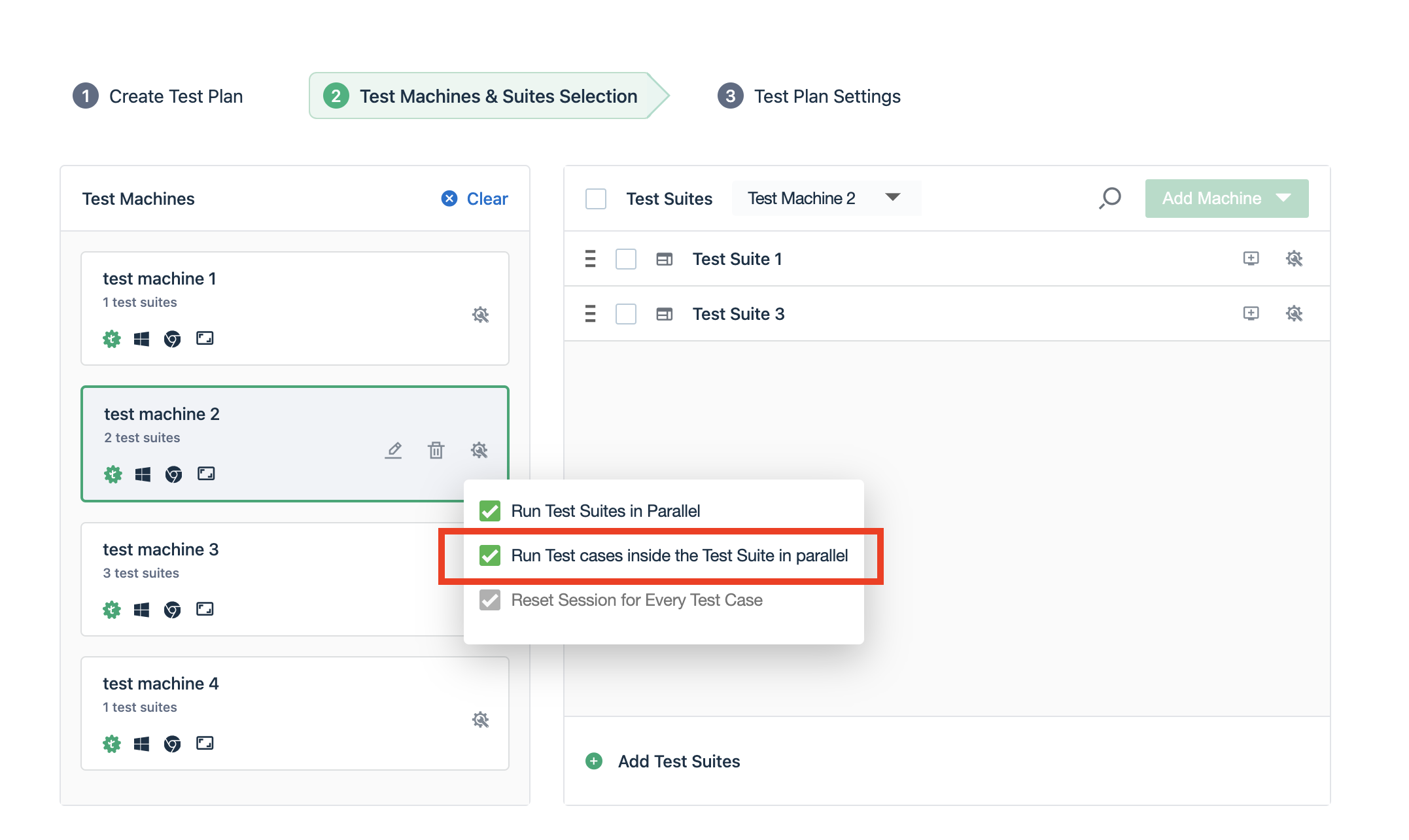
And if above option is enabled, there will be an option to Enable/Disable this for individual test suites too, as also shown in the screenshot below: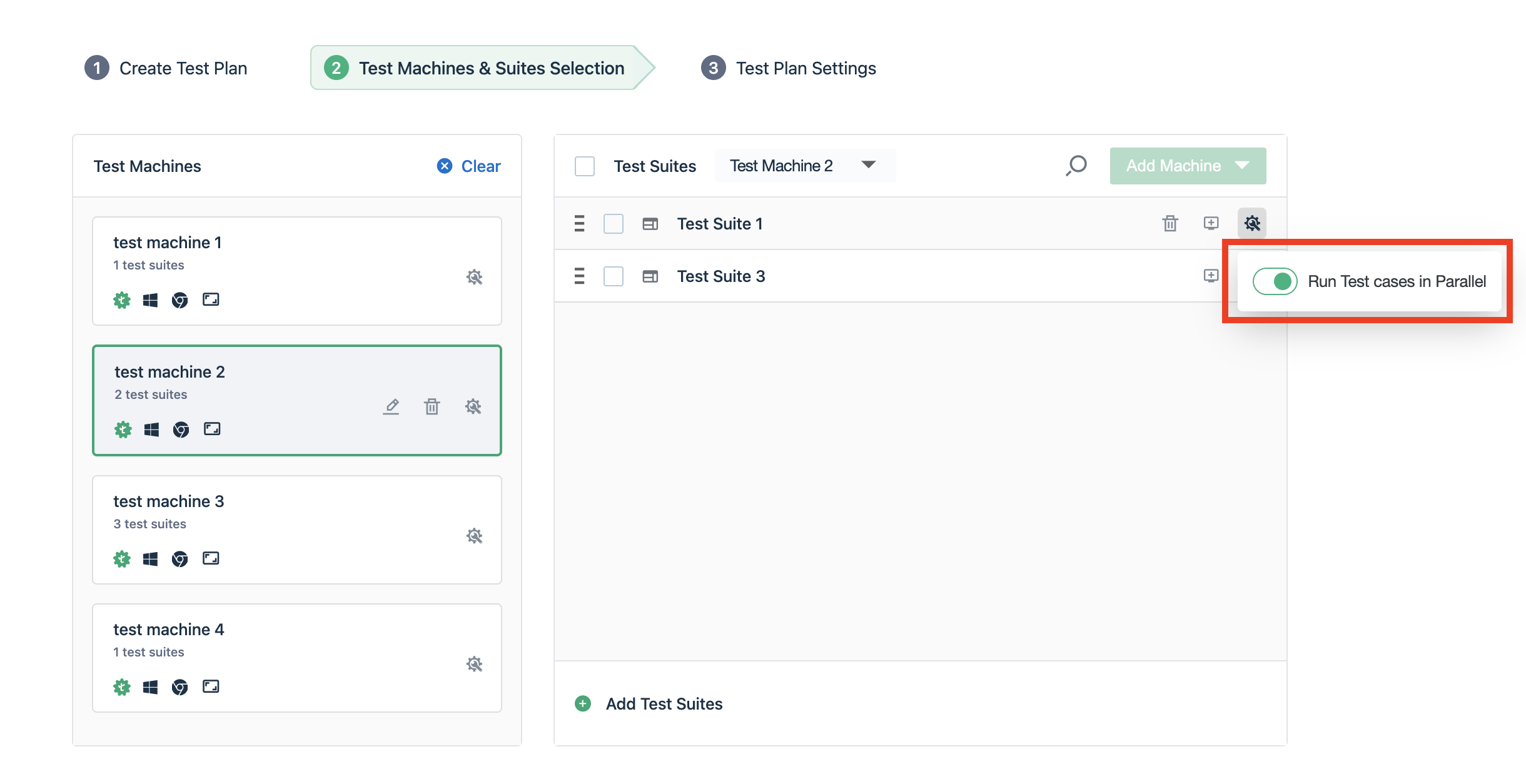
- Run Test Suites in Parallel: This option will be available for your test machine, if it has more than one test suite added. As highlighted in the screenshot below, OR
In case of an Android, iOS or a mobile web application - when you add a new machine for a test suite, by default - the test cases will run in parallel. The number of test cases that run in parallel will depend on the license you have. You can change this configuration from the Add Machine layover by going to the Settings icon and unchecking the Run Test cases inside the Test Suite in Parallel checkbox. The checkbox is also highlighted in the screenshot below.
Again, specifically in the case of an Android, iOS or a mobile web application, if you see that a machine does not get triggered (could be because of unavailability) for execution then you can add backup devices. These backup devices would be launched for test execution if the original device is not triggered successfully. The steps to add(link)/delete(link)/edit(link) a backup device are as below:
Add a backup device
- Select a Test suite.
- Add a Test Machine corresponding to the selected Test Suite
- On the Add Machine/Device layover, click on the Add backup devices button, the button is highlighted in the screenshot below:
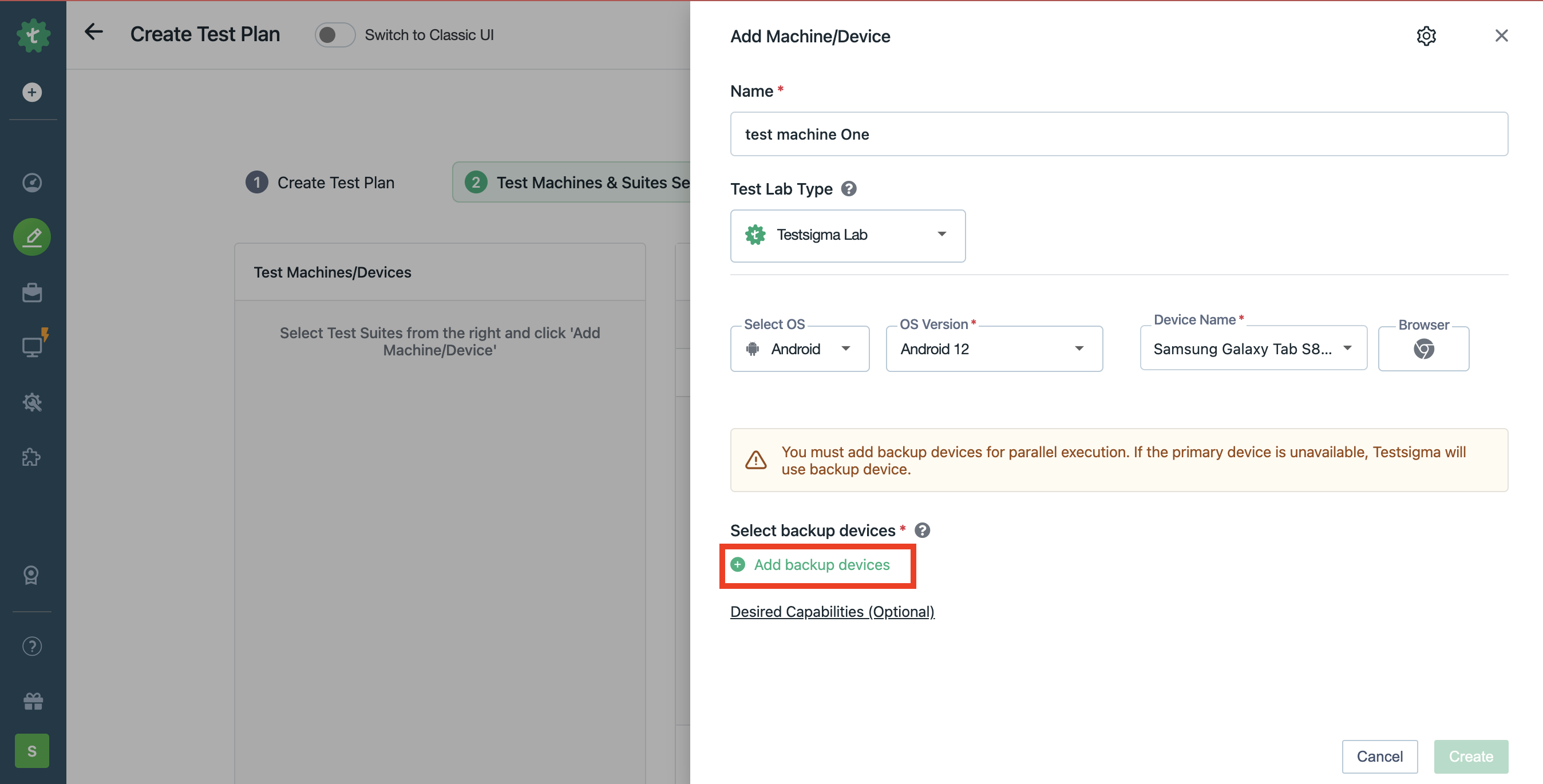
- Select the OS Version, Device Name for the added backup device.
- Fill in any other needed details and click on Create.
If your test case was configured for visual testing and the test was executed on a backup device, then the visual test execution will report the differences accordingly.
Alternatively, below is a GIF demonstrating the workflow to add a backup device for test execution for an Android, iOS or a mobile web application:
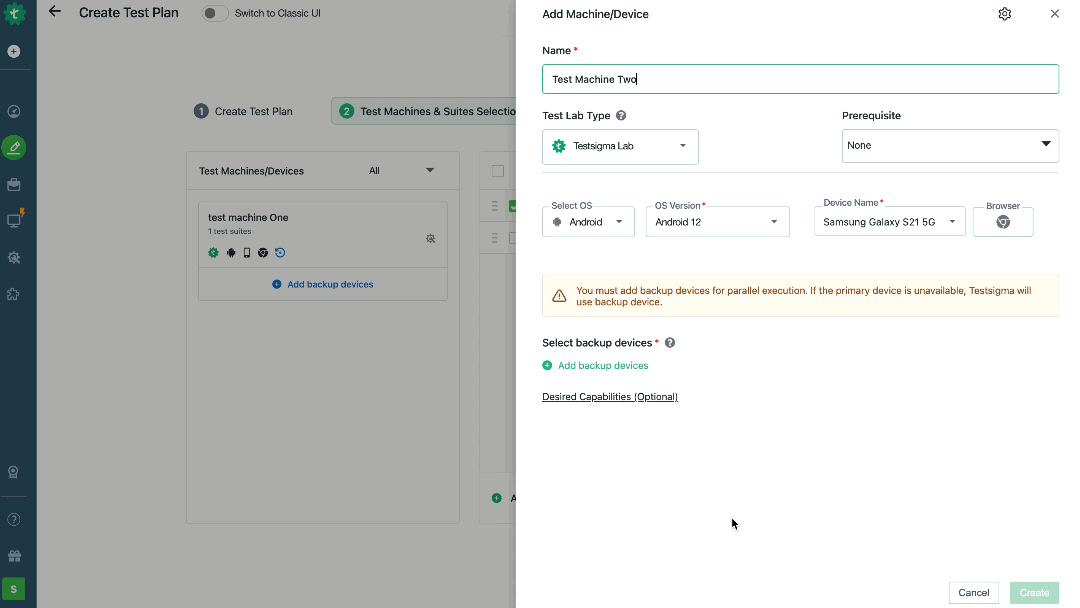
Edit a backup device
- Go to the Test Machine, corresponding to which you want to edit the backup device.
- Edit the needed configuration for the backup device - OS Version/Device Name/Browser
- Click on Update
Delete a backup device
- Go to the Test Machine, corresponding to which you want to delete the backup device. You can do this by click on the edit button corresponding to the Test Machine.
- On the "Add Machine/Device" layover that appears, click on the Delete button corresponding to the device that you want to delete. The delete button corresponding to a backup device is highlighted for your reference in the screenshot below:

Configure test cases inside a test suite to run in parallel, while creating a new test plan
By default, this feature is disabled for all accounts. If you need this feature enabled, please contact support.
You can also configure the test cases within a test suite to run in parallel.
Steps to configure:
- Start creating a test plan, as also done in the section above, and go to the second tab Test Machines & Suites Selection
- On the second tab, go to step 2 and add test suites for execution.
- Click on the Settings icon on the top right section of the test machine, and select the option Run test cases in test suite in parallel.

- Now, when you hover over the Settings icon corresponding to the added test suites - you will see the option Run in Parallel/Sequential.
 If you want to run the test cases within a test suite parallely, enable the toggle button Run Test Cases in Parallel corresponding to that test suite, as shown in the screenshot below:
If you want to run the test cases within a test suite parallely, enable the toggle button Run Test Cases in Parallel corresponding to that test suite, as shown in the screenshot below:

Configure tests to run in parallel with editing an existing test plan
On the Test Plans page, click on a Test Plan name to open the details page for that Test Plan, the Test Plan Details page will look something like this:
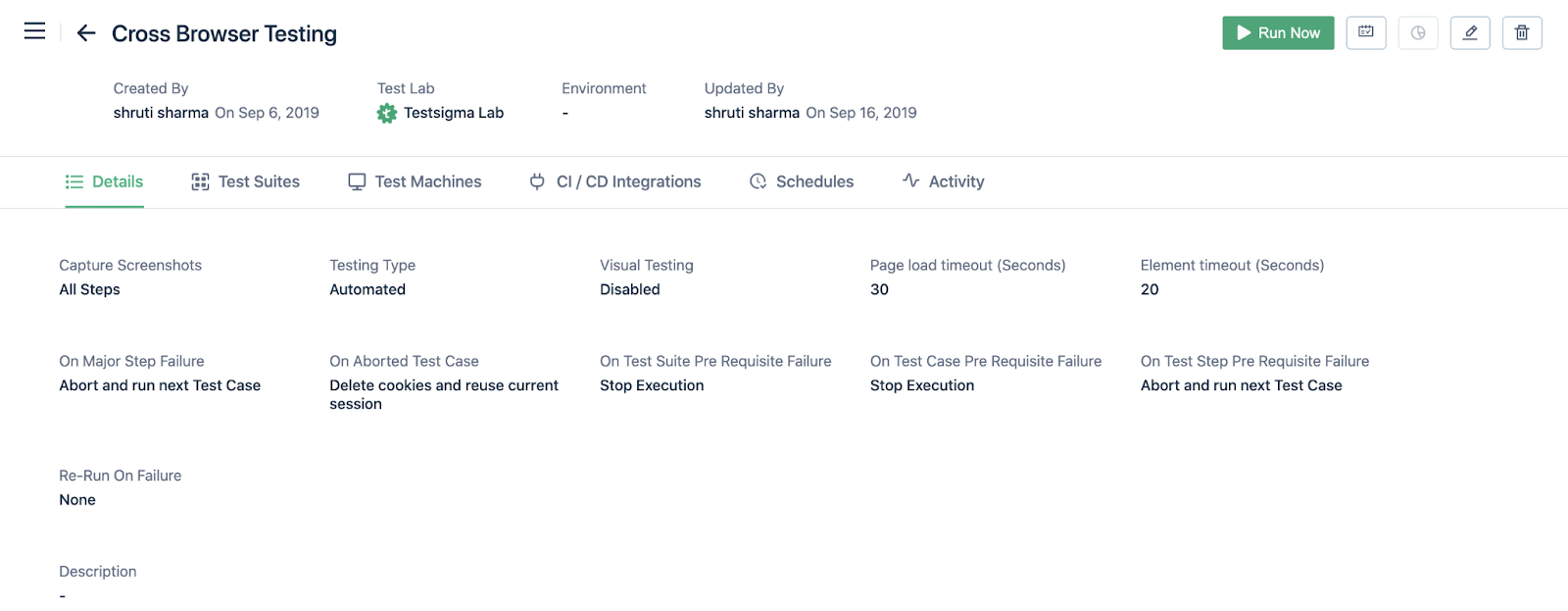
- Click on the Edit button on the top right corner as shown above:
- Go to the tab Test Machines & Suites Selection, follow the same steps as mentioned under Configure tests to run in parallel while creating a new Test Plan
You can configure your test plans per your subscription and the parallel/queued executions you have left.
For example, if you have a license for 1 parallel run and 1 queued run, you can run one test plan on one machine in parallel while queuing another test on a different machine for execution.
When you run a third test machine, it will not execute and will be thrown out of the execution queue since your subscription plan only allows one parallel run and one queued run at a time.
To run more test machines simultaneously, you need to upgrade to a higher subscription plan with more parallel and queued runs allowed.